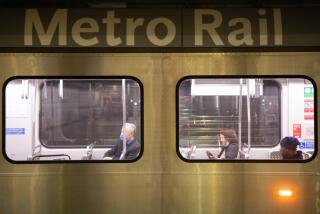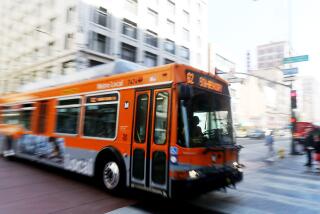Surviving on the RTD : With Security Stretched Thin and Reports of Crime Soaring on Inner-City Bus Lines, Those Who Can’t Afford Other Transportation Devise Own Safety Strategies
- Share via
Crime on bus lines in Central Los Angeles has more than tripled since 1988, but that’s no surprise to Vivian Cockrell.
Last month, five young thugs stormed the bus Cockrell was riding one night, stuck a gun to her face and robbed her and six other passengers before disappearing on a dark side street in Watts.
“I thought that was it,” Cockrell recalled on a recent night, as she and her two young children waited at a dimly lighted bus stop near 108th Street and Vermont Avenue. “I just gave them everything they wanted. As long as I could live, I didn’t care.”
Cockrell was not harmed, and the purse she handed over was empty. She says she knows better than to carry money, because for her and many of the half-million daily bus riders in Central Los Angeles, crime is a fact of life.
Citywide, incidents reported on buses and at bus stops increased 500% from 1988 to 1992, with 80% of those reports coming from Central Los Angeles, according to a City Times analysis of Southern California Rapid Transit District crime logs.
Crime--assaults, robberies, drug arrests, graffiti, counterfeiting and pickpocketing--increased 350% in Central Los Angeles over the same period, the data showed. About half of those crimes were committed in a 13-square-mile area that includes Downtown and the mostly immigrant neighborhoods west of there.
Meanwhile, average weekday ridership from 1988 through the first half of 1992 fell about 11% to 1.2 million. An RTD spokesman attributed the drop-off in part to the recession.
Despite the soaring crime rate, far less is spent for security on buses than on the new Metro Red Line subway or the Blue Line light rail. Only 3 cents is spent on security for each bus passenger, compared to $1.25 for each Blue Line rider and 29 cents per Red Line passenger based on current ridership, according to RTD estimates.
“Poor people use the buses and they don’t form much of a political constituency,” said UCLA Prof. Ned Levine, who directed a 1985 study of RTD crime. “If this were a middle-class problem, something would be done.”
RTD Board of Directors President Marvin Holen said all bus riders, not just poor ones, must endure inadequate security. Holen blames the rival Los Angeles County Transportation Commission, which he said controls about 60% of the RTD’s funds and has given priority to developing rail lines.
“There is nothing politically sexy about providing money for bus security,” Holen said.
But Neil Peterson, executive director of the transportation commission, said it has provided an extra $24 million to the RTD in the past three years to pay for 162 new officers. He also said the commission is paying 75% of the RTD’s current $13.4-million security budget.
“To draw a conclusion that we are less concerned about safety on buses than on rails is wrong,” he said.
While the bureaucrats point fingers, James Daggett dispenses wisdom on surviving the RTD from a seat on the No. 18 line, which he rides to work every day.
“You always have to keep your eyes wide open, but you never stare at anyone too long,” says Daggett, 50, a burly factory worker and a 23-year veteran of the city’s bus system.
Daggett has never had a problem, but he said he has seen a number of passengers who were not so lucky--like the woman whose purse was cut from her shoulder strap by a knife-wielding thief who knocked startled riders to the ground as he bolted out the back door.
“You just have to keep a prayer going because if something happens there’s nothing you can do,” said Loretta Smith, 49, a hotel worker who spends about four hours daily riding crowded buses from her home in South-Central to her job in Hollywood.
Smith said she lost $30 last year when someone snatched her purse on a bus. After that, she decided not to use the same bus line more than three times in a row in the hope of reducing her chances of becoming a crime victim. “I feel better that way,” she said.
For passenger James LeVar, there are two rules to live by: never ride a bus later than 10 p.m. and go to the nearest lighted area if approached by gang-bangers at a dark bus stop.
“They don’t like the light,” he said on a recent night, watching several youths drink and taunt passing cars near a bus stop at Century Boulevard and Figueroa Street.
Others take more drastic measures.
“I’m not going to let these young fools out on the street run over me,” said Jessie, a passenger in his mid-30s. To prove his point, Jessie opened his jacket to show off a small black handgun.
“I’d rather police catch me with it than be caught on the street without it,” he said as he left the No. 31 bus line in Boyle Heights.
Though the RTD Transit Police Department does not dispute the horror stories of some bus riders or City Times’ study of the agency’s crime logs, officials point out that most passengers are not crime victims. There were only .31 crimes per 100,000 passengers last year on the RTD, which serves 1.2 million daily riders in the counties of Los Angeles, Orange, Ventura and San Bernardino. That figure was up from the .18 crimes per 100,000 riders in 1988.
Police also say the crime is more a reflection of societal problems in troubled areas than a lack of security on the buses. “Yeah, we have an increase in crime on buses, but it’s not unique to the area in that the area has had an increase in crime as well,” said Capt. Dennis Conte, operations bureau commander for the RTD police.
According to data from the Los Angeles Police Department, Central Los Angeles accounted for about two-thirds of all the violent crimes reported citywide in 1992; comparable figures for 1988 were not available.
Conte also attributed the soaring number of crime reports to the increasing size of the RTD police force. With 245 officers--compared to 75 in 1988--the department can make more arrests and spot more crime, he said.
The issue of security aboard the buses was thrust into the spotlight in January after the “stagecoach robbery” of Cockrell’s bus in which teen-age robbers terrorized the passengers and driver at gunpoint. No arrests have been made.
Afterward, RTD police announced they had stepped up patrols on the No. 204 line, which runs along Vermont Avenue between Hollywood Boulevard and Manchester Avenue. Although the RTD police have always ridden buses, those efforts were not as intensive as the new patrols, in which officers board a bus about every 20 minutes between 5 a.m. and 9 p.m.
The No. 204 line was chosen because it is the most graffiti-plagued, crime-ridden line in the RTD. Riding with RTD officers on patrol shows why.
As a bus neared Pico Boulevard and Vermont, a beehive of drug activity, Officers Charles Lewis and Richard Lewis (who are not related) crouched next to the windows in the door wells and peered outside. A muscular man at the bus stop was pressing a bottle in a brown paper bag against his lips. A longhaired man waved a small plastic bag of what appeared to be marijuana.
As the two officers dashed out the door, the longhaired man tried to flee.
“I didn’t do nothing. Just some weed!” the man shouted, trying to twist free as he and the two officers wrestled on the sidewalk. “I’m not going to jail!”
More officers arrived to subdue the screaming, squirming suspect and carry him into the back of a patrol car.
“This is crazy,” remarked a woman cradling her baby at the bus stop.
But the action wasn’t over.
Apparently left unattended, the man escaped from the locked car and ran down Pico Boulevard with his wrists handcuffed behind him as startled onlookers jumped out of the way. But the officers, their semiautomatic handguns drawn, found him several minutes later inside a dark, empty building.
Later, the two RTD officers boarded another bus and exited at another hot spot, the stop at Martin Luther King Jr. Boulevard and Vermont. The stop is favored by taggers and thieves because four lines meet there.
No sooner did Charles Lewis and Richard Lewis arrive than they were flagged down by a hysterical Julio Canales, who was waving a copy of a crime report. He said he had spotted the youth who pistol-whipped him and stole $530 a week earlier as he waited for a bus. The youth was at a bus stop across the street.
Additional officers on a nearby foot patrol arrived, and after a round of questions, they handcuffed the 15-year-old. But the action was little consolation for Canales, who said he and his wife and two children were evicted from their home only hours earlier because he had no money to pay the rent.
“Because of him, I’m on the street,” Canales said, making a gesture at the baby-faced boy in the back of a squad car.
RTD police say the patrols have resulted in about a 40% reduction in graffiti on the No. 204 line, and passengers and drivers say they feel safer. “It’s absolutely made a difference,” said driver Abdul Hassan, 53.
Added Veronica Rosales, 66, who has been riding the line for seven years: “Now we don’t have to worry about these young boys taking over the buses.”
But their newfound sense of security may be short-lived.
The patrols are funded with $1.4 million in Proposition A money that was allocated to Supervisor Yvonne Brathwaite Burke’s office. But RTD officials say the money will run out in mid-March.
Some officers say the patrols have just pushed the crime a block or two away. And passengers on other lines say they, too, would like the same protection. But police say the 245-officer force is already stretched thin trying to protect the new Red Line and the RTD’s approximately 2,000 buses that crisscross 4,519 miles of bus lines in four counties.
Los Angeles City Councilman Richard Alatorre, chairman of the newly created Metropolitan Transit Authority, said bus security will be a priority under the MTA.
The MTA was created by state legislation ordering the merger of the RTD and County Transportation Commission, which have feuded for nearly two decades over how money should be spent for transportation improvements. The merger will take place over the next couple of months.
“Safety has not been a priority, but it will be now that I’m on board,” Alatorre said.
Peterson of the LACTC said a task force that includes local law enforcement officials is studying ways to improve bus security and will issue recommendations in a couple of months.
Holen and others say there has not been enough public outcry demanding more security on the buses. “We see the lack of security on the buses as a symptom of the broader reality that the bus system is not getting enough funding,” said Lisa Hoyos-Tweeten, spokeswoman for the Labor/Community Strategy Center, which has argued at public hearings that buses have taken a back seat to rail transportation.
And a reason for that situation, Hoyos-Tweeten and others contend, is that most bus riders are poor and not Anglo.
According to the RTD, 61% of its 1.3 million daily riders last year earned less than $15,000 annually, with only 5% making more than $50,000 a year. The median annual income level for Los Angeles County was $33,167, the 1990 U.S. Census showed.
Latinos made up 49% of the riders in the Downtown area, blacks 16% and Asians 11%, according to an RTD survey taken in the area last year. No figures were available for other parts of the city.
Police say many crime victims are Latino immigrants. Fearful of authorities, immigrants are less likely to report problems--a fact not lost on criminals who roam the bus lines in the Downtown/Pico--Union corridor.
“The animals who are likely to prey on these people do so because of the perception that they are less likely to go to the police,” said Conte, the RTD captain.
The heavily Latino area of Downtown on Broadway is teeming with pickpockets and sellers of counterfeit bus passes, police say. Last year alone, the RTD lost about $3 million in counterfeit passes, although officials say new metal tokens should cut down on the problem.
At a bus stop on Broadway, Irene Diaz boarded a crowded No. 30 bus line headed to her East Los Angeles home. The 62-year-old grandmother said she has never been a crime victim but is worried that the buses seem to be getting crazier.
“I don’t have a lot of confidence,” she says. “You just can’t trust anyone anymore.”
* Crime and the RTD About 62% of bus crimes reported in 1992 in Central Los Angeles occurred in the Central and Rampart police divisions that cover Downtown and the mostly immigrant communities west of Downtown. Types of Crime There has been a sharp rise in some types of bus-related crime over the last five years in Central Los Angeles. Robberies tripled, assaults nearly doubled and the counterfeit bus-pass business flourished. There was also one homicide reported in 1992 in the Wilshire Division. *Assaults ‘88: 169 ‘92: 330 Drugs ‘88: 10 ‘92: 252 Fake bus passes ‘88: 1 ‘92: 575 Graffiti ‘88: 115 ‘92: 198 Pickpockets ‘88: 128 ‘92: 120 Robberies ‘88: 61 ‘92: 187 *Rampart ‘88: 91 ‘92: 490 Wilshire ‘88: 65 ‘92: 133 Southwest ‘88: 27 ‘92: 122 77th Street ‘88: 60 ‘92: 114 Southeast ‘88: 10 ‘92: 43 Newton ‘88: 29 ‘92: 90 Hollenbeck ‘88: 16 ‘92: 67 Northeast ‘88: 50 ‘92: 52 Central ‘88: 136 ‘92: 553 Source: RTD
More to Read
Sign up for Essential California
The most important California stories and recommendations in your inbox every morning.
You may occasionally receive promotional content from the Los Angeles Times.














